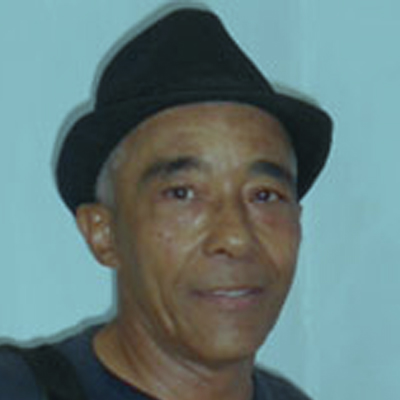Conocí la obra de Lacoste en la publicación humorística cubana “Palante”.
Este humorista gráfico habanero es ingeniero como yo y nacimos en el mismo año. También es diseñador y pintor. Ha colaborado y colabora en diversas publicaciones cubanas y extranjeras. Sus obras se han mostrado en exposiciones colectivas en varios países. En el 2008 le publicaron su primer libro. Y ha obtenido premios y disticiones en concursos nacionales e internacionales.
(Este vis a vis lo realizamos en 2014).
PP: Estimado, ¿te gusta que te hagan entrevistas?
LACOSTE: Me gusta que me hagan entre-vistas, siempre que sean entre-tragos y que por supuesto invite el entrevistador.
PP: Lo siento, creo que vas a hacer un excepción con esta, porque beber online no es fácil, a no ser que por zoom tú tomes allá y yo a aquí (pero no invito yo, aunque me hubiera gustado). Pues comienzo…¿cómo ves el estado actual del humor en Cuba, en televisión, radio, teatro, literatura y gráfica este año?
LACOSTE: En Cuba siempre ha existido tradición de buenos programas humorísticos en los medios (Radio y TV) pero últimamente escasean. Creo que existen buenos humoristas, pero la mayoría de las veces los guiones no son buenos. En la gráfica y la literatura existe el talento, pero falta el papel y el espacio donde publicar es muy escaso.
PP: No es muy “festiva” tu respuesta. Pero, ¿has pensado que quizás hayan guionistas buenos, pero productores, directores o ejecutivos malos? Esa variante la he visto yo. Lo de la falta de papel sí no de depende del talento humorístico. Qué lástima. Bueno, continúo… En varios países de América Latina se dice: "Mi país es un pueblo de humoristas", "En mi país, tú mueves una piedra y sale un humorista", etc. ¿En el país donde vives se dice lo mismo?
LACOSTE: Sí. Se dice que en la idiosincrasia del cubano está implícito el humor.
PP: Sí, y también se dice que eso que abunda no es humor, se confunde con choteo. Es algo siempre a profundizar. Por lo menos a mí me interesa mucho. Y dime algo, ¿según tu criterio, es verdad la acuñada frase: "Es más fácil hacer llorar que hacer reír”?
LACOSTE: Si eres bueno haciendo cosquillas no es válida esa expresión.
PP: Bueno, he visto niños que lloran a veces cuando les haces cosquillass, ja, ja. Bueno, ¿cuándo decidiste hacerte humorista?
LACOSTE: Cuando mi salario como ingeniero mecánico dejó de alcanzarme para satisfacer mis necesidades, decidí acogerme a mi pasión de toda la vida, el dibujo y la pintura. Mis libretas escolares siempre estaban llenas de caricaturas de profesores y compañeros de aula y precisamente lo primero que se me ocurrió hacer fue caricaturas de artistas y personajes de la televisión. Cuando pensé que eran publicables las llevé a una publicación humorística y ¡Eureka! Les gustó y comencé a publicar en el mismo periódico donde trabajo actualmente.
PP: Ahí conocí tu obra, como dije presentándote. Oye, ¿y para ti el humorista nace o se hace?
LACOSTE: Se nace, y se desarrolla con mucho trabajo, estudio y tesón.
PP: ¿Puedes contarme cuál ha sido el mejor y el peor momento de su carrera en el humor hasta el día de hoy?
LACOSTE: El mejor, cuando obtuve mi primer premio en un salón internacional de humor gráfico. Y el peor, cada vez que me censuran una caricatura.
PP: Me imagino ambos casos. Me pasaría lo mismo. Oye, Lacoste, como profesional del humor, dime, ¿te ríes fácil? ¿Con qué tipo de chistes?
LACOSTE: Muchas personas creen que los humoristas somos gentes que nos pasamos la vida de carcajada en carcajada, pero la profesión de humorista es tan seria como la del funerario, a propósito los chistes que más me gustan son los de humor negro, me hacen reír fácilmente cuando reflexiono sobre que realmente estamos de paso en este mundo y lo significativamente corta que es la vida.
PP: A mí también me encanta el humor negro. Y para amenizar más esta conversación, ¿me cuentas alguna anécdota relacionada con nuestra profesión?
LACOSTE: En una ocasión publiqué en “Palante”, revista donde trabajo desde el año 2000, un trabajo satírico sobre la gestión de una determinada empresa pecuaria estatal en la cría de búfalos. Se hizo en base a un artículo muy crítico que había salido en la prensa (periódico Granma). Yo escribí el texto donde les sugería que contrataran a Búfalo Bill para que pusiera coto al desorden que tenía aquella empresa y además hice las caricaturas, pero nunca estuvimos en aquel lugar, ni conocimos personalmente a ninguno de los trabajadores de dicha empresa.
Al cabo de los días de publicado el artículo con los dibujos, se apareció en la redacción un funcionario del ministerio de la agricultura a quejarse por el trabajo, le explicamos que la crítica también era un medio en el que se desenvolvía el humor, pero de una forma satírica y que si había salido un artículo seriamente crítico en Granma, por qué venia a quejarse precisamente con nosotros.
Cuando creíamos haberlo convencido, aquel hombre nos sale con el planteamiento de “que en definitiva lo que más les dolía no era la crítica sino que en una de las caricaturas nos burláramos crudamente del director de la empresa caricaturizándolo despiadadamente y que el compañero estaba muy dolido con dicha burla”. Resulta que uno de los dibujos representaba un ring de boxeo con dos boxeadores y un juez donde se declaraba vencedor levantándole “el brazo” enguantado al búfalo y el derrotado en su camiseta llevaba el letrero de Empresa Pecuaria. Se trataba de un muñeco cualquiera con las características de los que hago siempre: narizón, con la cabeza grande, etc, y por supuesto todo golpeado, pero que casualmente, según el funcionario ¡Era idéntico al director de la empresa!
No hubo manera de convencerlo de que fue pura casualidad y nos acusaba indignado de que nos habíamos puesto de acuerdo con el periodista que fue a la empresa, el cual seguramente nos había pasado clandestinamente una foto del director para que lo caricaturizáramos.
La sub-directora de nuestro periódico (que estaba presente) y yo nos miramos y al percatarnos de la simpática coincidencia y del gracioso malentendido, nos dio por reír y aquel hombre nos miraba atónito con las venas del cuello a punto de reventárseles y nos vociferaba: ¡Ah, pero encima de eso se ríen! ¡Es el colmo de la falta de respeto con el compañero director de la empresa!... lo que por supuesto nos daba más risa.
Aunque fue un momento de hilaridad, pasamos un mal rato por la gran tensión que se produjo, pero por suerte la sangre no llegó al río y todo se resolvió civilizadamente.
PP: Muy buena anécdota... Amigo mío, ¿con cuáles colegas te identificas más?
LACOSTE: Con todos los que sean honestos, sinceros y buenos amigos.
PP: ¿Con tan pocos te identificas?, Ja, ja, creo que eres muy exigente. Bueno, y para ir cerrando, ¿qué me aconsejas a mí como humorista?
LACOSTE: Que cojas la vida con buen humor.
PP: Creo que lo hago, aunque seguro que se podría un poco más.
Bueno, Lacoste, mil gracias por aceptar participar en este vis a vis, sobre todo sabiendo que en la vida hay poco tiempo para estas cosas.
¡Te deseo mucha salud, suerte y éxitos!
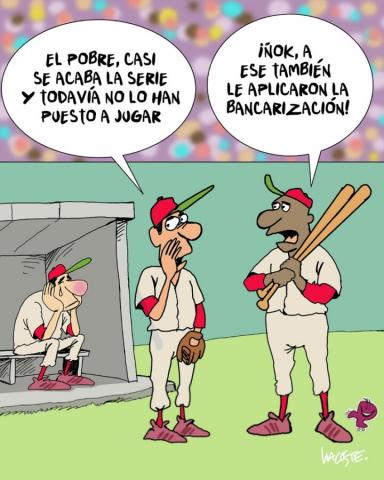
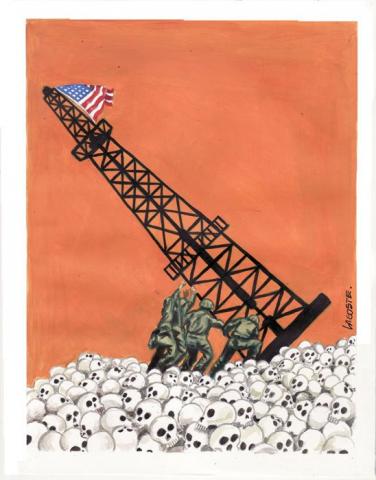
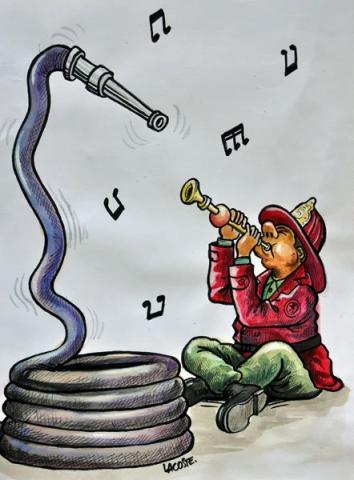
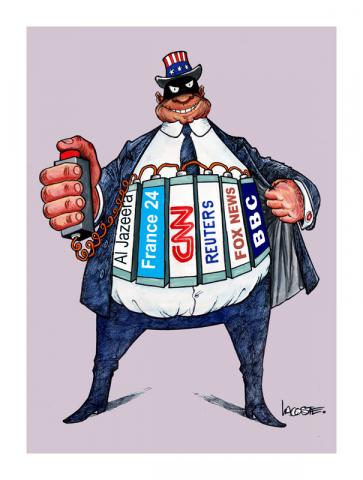
Interview with Enrique Lacoste
by Pepe Pelayo
I discovered Lacoste’s work in the Cuban humor magazine Palante.
This Havana-born graphic humorist is an engineer, just like me, and we were born in the same year. He is also a designer and painter. He has collaborated and continues to collaborate with various Cuban and international publications. His works have been featured in group exhibitions in several countries. In 2008, his first book was published, and he has received awards and distinctions in national and international competitions.
(This interview took place in 2014.)
PP: Dear friend, do you enjoy being interviewed?
LACOSTE: I enjoy being “inter-viewed,” as long as it’s “inter-drinks” and, of course, the interviewer is buying.
PP: Sorry, I think you’ll have to make an exception for this one, since drinking online isn’t easy—unless via Zoom you drink there and I drink here (but I’m not buying, though I would’ve liked to). Let’s get started… How do you see the current state of humor in Cuba—on television, radio, theater, literature, and graphic art this year?
LACOSTE: Cuba has always had a tradition of good humor programs in the media (radio and TV), but lately, they’ve become scarce. I think there are talented humorists, but most of the time, the scripts aren’t good. In graphic art and literature, there’s talent, but there’s a lack of paper, and publishing spaces are very limited.
PP: That’s not a very “cheerful” answer. But have you considered that maybe there are good scriptwriters, but poor producers, directors, or executives? I’ve seen that happen. The lack of paper definitely doesn’t depend on comedic talent. What a shame. Moving on… In several Latin American countries, people say things like, “My country is a nation of humorists,” or “In my country, if you turn over a rock, you’ll find a humorist.” Do people say the same in the country where you live?
LACOSTE: Yes. It’s said that humor is implicit in the Cuban idiosyncrasy.
PP: True, but it’s also said that what’s abundant isn’t always humor; it’s often mistaken for mockery. That’s something worth delving into—at least, I find it very interesting. Tell me, in your opinion, is the phrase “It’s easier to make someone cry than to make them laugh” true?
LACOSTE: If you’re good at tickling, that phrase doesn’t hold up.
PP: Well, I’ve seen kids cry sometimes when you tickle them, ha ha. When did you decide to become a humorist?
LACOSTE: When my salary as a mechanical engineer was no longer enough to meet my needs, I decided to turn to my lifelong passion: drawing and painting. My school notebooks were always filled with caricatures of teachers and classmates, and the first thing I thought of doing was caricatures of artists and TV personalities. When I thought they were good enough to be published, I brought them to a humor magazine and—Eureka! They liked them, and I began publishing in the same magazine where I still work today.
PP: That’s where I first encountered your work, as I mentioned earlier. Tell me, do you think a humorist is born or made?
LACOSTE: Born, but it’s developed with a lot of work, study, and perseverance.
PP: Can you tell me about the best and worst moments of your humor career so far?
LACOSTE: The best moment was when I won my first prize in an international graphic humor competition. The worst? Every time one of my cartoons gets censored.
PP: I can imagine both situations—I’d feel the same way. As a professional humorist, tell me, do you laugh easily? What kind of jokes make you laugh?
LACOSTE: Many people think humorists spend their lives laughing nonstop, but the profession is as serious as that of a funeral director. Incidentally, the jokes I like the most are dark humor—they make me laugh easily when I reflect on the fact that we’re just passing through this world and how significantly short life is.
PP: I love dark humor too. To make this conversation even more enjoyable, can you share an anecdote related to our profession?
LACOSTE: Once, I published a satirical piece in Palante, the magazine where I’ve worked since 2000, about the management of a specific state livestock company raising buffalo. It was based on a very critical article that had appeared in the press (Granma newspaper). I wrote a text suggesting they hire Buffalo Bill to bring order to the chaos in that company and included caricatures, but we had never visited the place or met any of the company’s workers personally.
A few days after the article was published, a ministry of agriculture official showed up at our office to complain about the piece. We explained that criticism is also a form of humor, expressed satirically, and that if a serious critical article had appeared in Granma, why was he complaining to us?
When we thought we’d convinced him, he said that what hurt them the most wasn’t the critique itself but that in one of the cartoons, we had ruthlessly mocked the company’s director. He claimed the caricature looked exactly like the director, and that the man was very upset about it.
The cartoon in question depicted a boxing ring with two fighters and a referee declaring the buffalo the winner, raising its gloved arm, while the defeated fighter wore a shirt labeled “Livestock Company.” The figure was just a generic caricature: big-nosed, large-headed, and, of course, battered. But, as it turned out, it supposedly bore an uncanny resemblance to the company director!
We couldn’t convince him it was pure coincidence, and he accused us of colluding with the journalist who wrote the article, suggesting they had secretly passed us a photo of the director to caricature him.
The assistant editor and I looked at each other, realizing the humorous coincidence and misunderstanding, and started laughing. The man, veins bulging in his neck, shouted at us: “Oh, so now you’re laughing on top of it all? This is the height of disrespect for the company director!” Of course, that made us laugh even more.
Although it was a moment of hilarity, the tension made it uncomfortable. Fortunately, things were resolved civilly, and no further issues arose.
PP: What a great story! My friend, which colleagues do you identify with the most?
LACOSTE: All those who are honest, sincere, and good friends.
PP: That’s not many, ha ha. I guess you’re very selective. To wrap things up, what advice would you give me as a humorist?
LACOSTE: Take life with a good sense of humor.
PP: I think I already do, though I’m sure I could do it even more.
Thank you so much, Lacoste, for agreeing to this interview, especially knowing how little time we have for such things in life.
I wish you much health, luck, and success!
(This text has been translated into English by ChatGPT)

